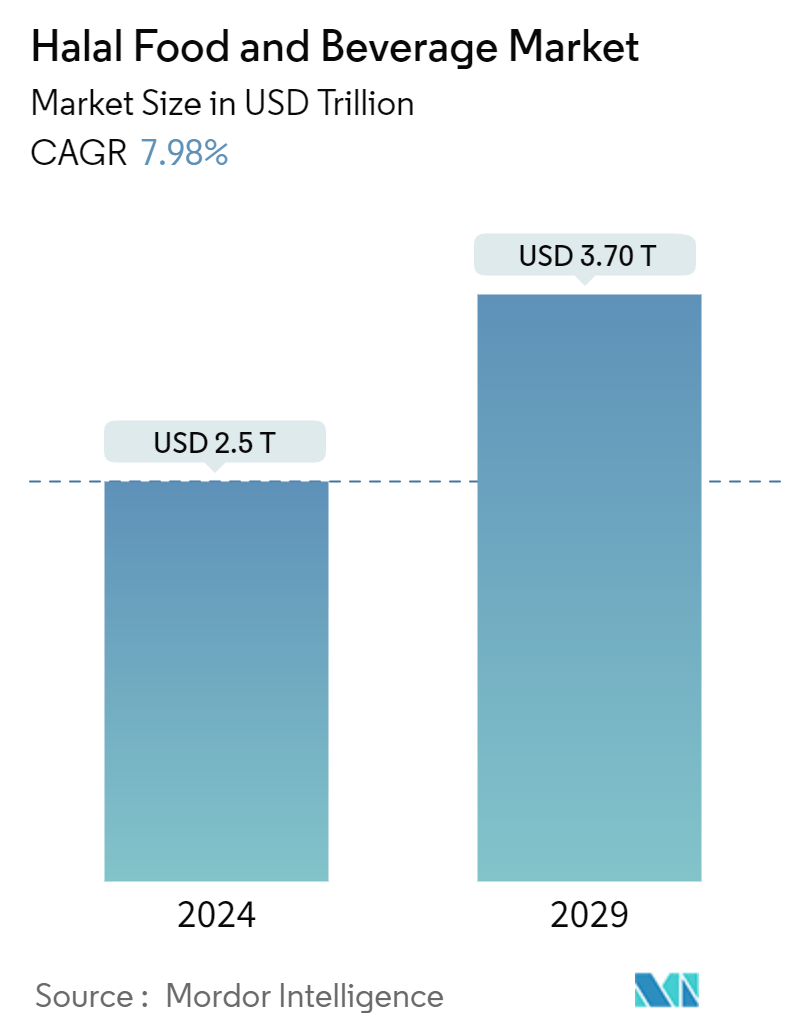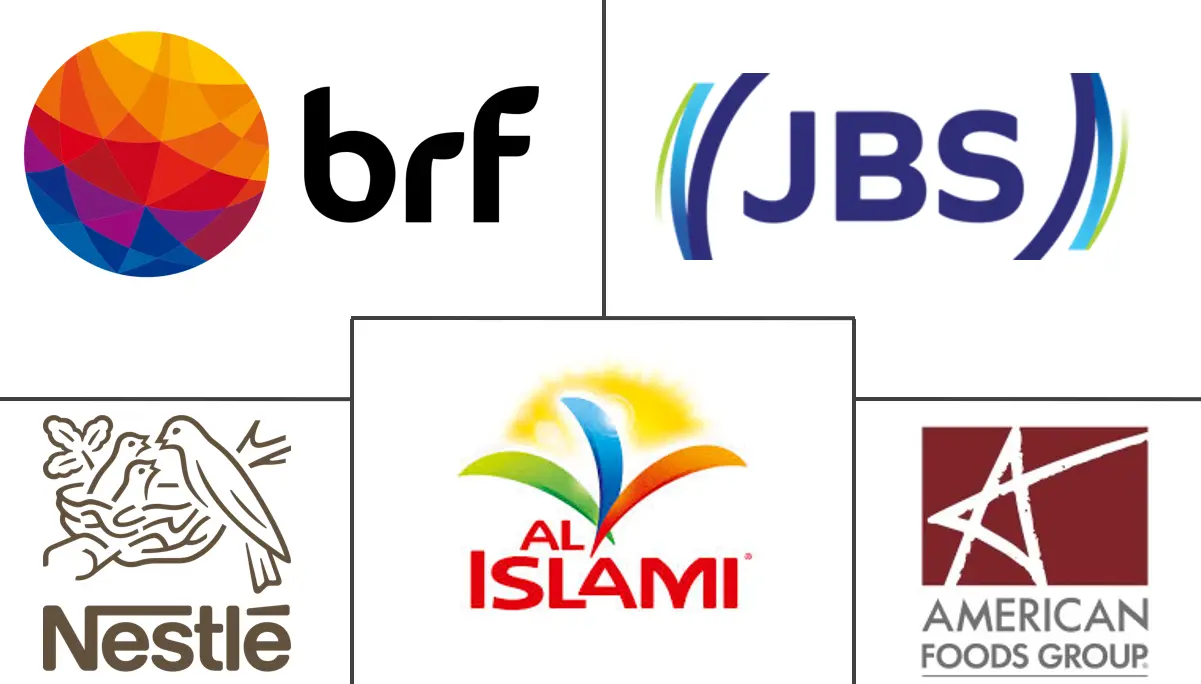Market Size of Halal Food & Beverage Industry

| Study Period | 2019 - 2029 |
| Market Size (2024) | USD 2.5 Trillion |
| Market Size (2029) | USD 3.70 Trillion |
| CAGR (2024 - 2029) | 7.98 % |
| Fastest Growing Market | Asia Pacific |
| Largest Market | Middle East and Africa |
Major Players
*Disclaimer: Major Players sorted in no particular order |
Halal Food & Beverage Market Analysis
The Halal Food & Beverage Market size is estimated at USD 2.5 trillion in 2024, and is expected to reach USD 3.70 trillion by 2029, growing at a CAGR of 7.98% during the forecast period (2024-2029).
The halal foods and beverages market is experiencing significant growth globally, driven by the rising demand for products that comply with Islamic dietary laws. Halal certification ensures that food and beverages are prepared according to strict religious guidelines, making them permissible for Muslims to consume. This market is expanding in predominantly Muslim countries and gaining traction in regions like North America and Europe, where an increasing number of consumers are seeking out halal-certified products for their perceived quality, ethical standards, and health benefits.
Companies across various sectors are recognizing the potential of the halal food and beverage market and are launching new ventures to tap into this lucrative segment. For instance, in October 2022, the Public Investment Fund (PIF) announced the launch of the Halal Products Development Company. This initiative aims to enhance the efficiency of the Saudi Arabian halal production industry, promote local innovation, and support global exports. Leveraging Saudi Arabia's significant position in the Islamic world, the company seeks to strengthen the local halal ecosystem. The Middle East is a significant producer and consumer of halal food, with countries investing in developing the sector to meet local and international demand.
Halal Food & Beverage Industry Segmentation
Halal food and beverages constitute products prepared strictly by Islamic dietary law. Halal products are considered lawful and hygienic. The halal foods and beverages market is segmented by type, distribution channel, and geography. By type, the market is segmented into halal food, halal beverages, and halal supplements. By distribution channel, the market is segmented into supermarkets and hypermarkets, convenience stores, online retail stores, and other distribution channels. Furthermore, by geography, the market is segmented into North America, Europe, Asia-Pacific, South America, and Middle East and Africa. The market sizing has been done in value (USD) for all the abovementioned segments.
| By Type | |
| Halal Food | |
| Halal Beverages | |
| Halal Supplements |
| By Distribution Channel | |
| Supermarkets and Hypermarkets | |
| Convenience Stores | |
| Online Retail Stores | |
| Other Distribution Channels |
| Geography | ||||||||||
| ||||||||||
| ||||||||||
| ||||||||||
| ||||||||||
|
Halal Food & Beverage Market Size Summary
The halal food and beverage market is experiencing a resurgence following a slight decline during the COVID-19 pandemic, which notably affected the consumption of red meat. Companies have responded by innovating and expanding their product offerings, such as Bilal Group's introduction of new halal meat dishes. The market is poised for significant growth, driven by increasing consumer interest in organic and natural products, and the expanding availability of halal beverages in Western grocery stores. The demand for halal products is rising among both Muslim and non-Muslim consumers, attributed to the perceived hygiene benefits and quality assurance provided by halal certification. This trend is further bolstered by the growing global Muslim population and the increasing expenditure on halal products, particularly in regions with large Islamic communities.
The Middle East and Africa region leads in demand for halal products, supported by a substantial Islamic population and government regulations mandating halal certification. The competitive landscape of the global halal food and beverage market features major players like Nestlé SA and Al Islami Foods, who leverage brand loyalty and geographic presence to maintain their market positions. These companies are focused on expanding their offerings and enhancing brand awareness to gain consumer trust. Recent developments, such as Crescent Foods' new halal service in the United States and the launch of deenary.com in Italy, highlight the market's dynamic nature and the ongoing efforts to cater to the needs of Muslim consumers worldwide.
Halal Food & Beverage Market Size - Table of Contents
-
1. MARKET DYNAMICS
-
1.1 Market Drivers
-
1.1.1 Growing Muslim Population Supporting Demand
-
1.1.2 Halal Certification Introducing a New Consumer Base
-
-
1.2 Market Restraints
-
1.2.1 Fraudulence Associated with Mislabeling Halal Meat Products
-
-
1.3 Porter's Five Forces Analysis
-
1.3.1 Threat of New Entrants
-
1.3.2 Bargaining Power of Buyers/Consumers
-
1.3.3 Bargaining Power of Suppliers
-
1.3.4 Threat of Substitute Products
-
1.3.5 Intensity of Competitive Rivalry
-
-
-
2. MARKET SEGMENTATION
-
2.1 By Type
-
2.1.1 Halal Food
-
2.1.2 Halal Beverages
-
2.1.3 Halal Supplements
-
-
2.2 By Distribution Channel
-
2.2.1 Supermarkets and Hypermarkets
-
2.2.2 Convenience Stores
-
2.2.3 Online Retail Stores
-
2.2.4 Other Distribution Channels
-
-
2.3 Geography
-
2.3.1 North America
-
2.3.1.1 United States
-
2.3.1.2 Canada
-
2.3.1.3 Mexico
-
2.3.1.4 Rest of North America
-
-
2.3.2 Europe
-
2.3.2.1 Germany
-
2.3.2.2 United Kingdom
-
2.3.2.3 Spain
-
2.3.2.4 France
-
2.3.2.5 Italy
-
2.3.2.6 Russia
-
2.3.2.7 Rest of Europe
-
-
2.3.3 Asia-Pacific
-
2.3.3.1 China
-
2.3.3.2 Japan
-
2.3.3.3 India
-
2.3.3.4 Australia
-
2.3.3.5 Indonesia
-
2.3.3.6 Malaysia
-
2.3.3.7 Singapore
-
2.3.3.8 Rest of Asia-Pacific
-
-
2.3.4 South America
-
2.3.4.1 Brazil
-
2.3.4.2 Argentina
-
2.3.4.3 Rest of South America
-
-
2.3.5 Middle East and Africa
-
2.3.5.1 South Africa
-
2.3.5.2 Egypt
-
2.3.5.3 Saudi Arabia
-
2.3.5.4 United Arab Emirates
-
2.3.5.5 Oman
-
2.3.5.6 Rest of Middle East and Africa
-
-
-
Halal Food & Beverage Market Size FAQs
How big is the Halal Food & Beverage Market?
The Halal Food & Beverage Market size is expected to reach USD 2.5 trillion in 2024 and grow at a CAGR of 7.98% to reach USD 3.70 trillion by 2029.
What is the current Halal Food & Beverage Market size?
In 2024, the Halal Food & Beverage Market size is expected to reach USD 2.5 trillion.

